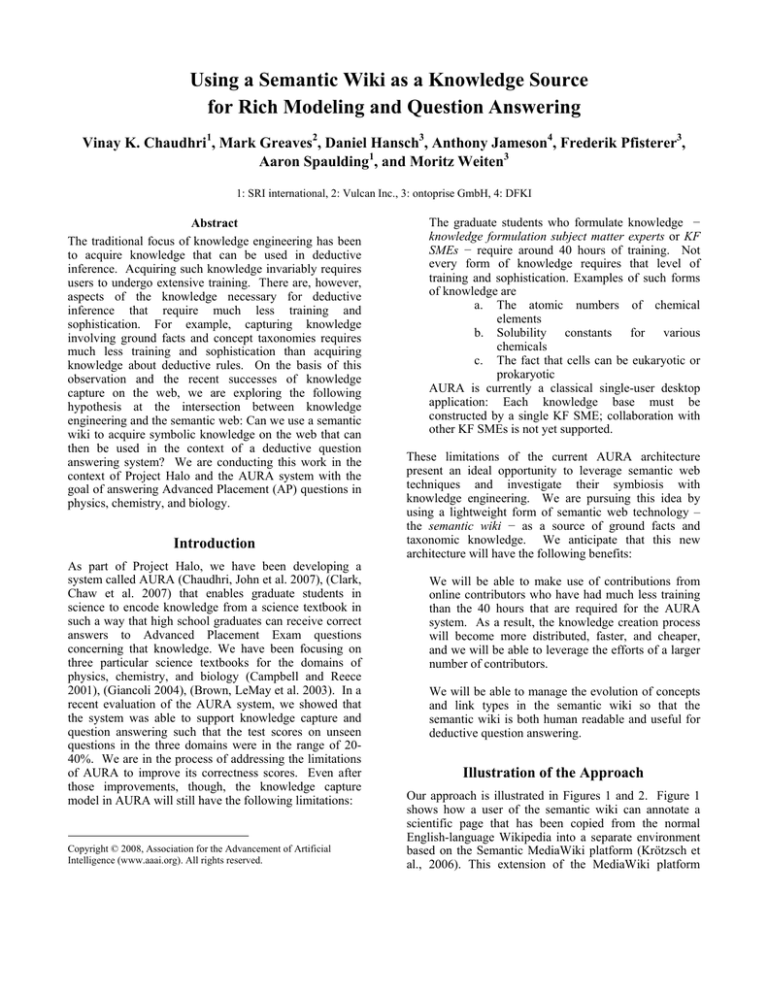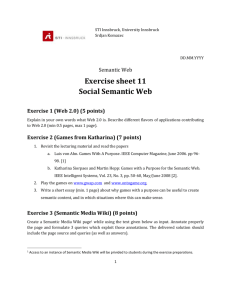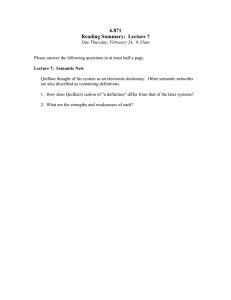
Using a Semantic Wiki as a Knowledge Source
for Rich Modeling and Question Answering
Vinay K. Chaudhri1, Mark Greaves2, Daniel Hansch3, Anthony Jameson4, Frederik Pfisterer3,
Aaron Spaulding1, and Moritz Weiten3
1: SRI international, 2: Vulcan Inc., 3: ontoprise GmbH, 4: DFKI
Abstract
The traditional focus of knowledge engineering has been
to acquire knowledge that can be used in deductive
inference. Acquiring such knowledge invariably requires
users to undergo extensive training. There are, however,
aspects of the knowledge necessary for deductive
inference that require much less training and
sophistication. For example, capturing knowledge
involving ground facts and concept taxonomies requires
much less training and sophistication than acquiring
knowledge about deductive rules. On the basis of this
observation and the recent successes of knowledge
capture on the web, we are exploring the following
hypothesis at the intersection between knowledge
engineering and the semantic web: Can we use a semantic
wiki to acquire symbolic knowledge on the web that can
then be used in the context of a deductive question
answering system? We are conducting this work in the
context of Project Halo and the AURA system with the
goal of answering Advanced Placement (AP) questions in
physics, chemistry, and biology.
Introduction
As part of Project Halo, we have been developing a
system called AURA (Chaudhri, John et al. 2007), (Clark,
Chaw et al. 2007) that enables graduate students in
science to encode knowledge from a science textbook in
such a way that high school graduates can receive correct
answers to Advanced Placement Exam questions
concerning that knowledge. We have been focusing on
three particular science textbooks for the domains of
physics, chemistry, and biology (Campbell and Reece
2001), (Giancoli 2004), (Brown, LeMay et al. 2003). In a
recent evaluation of the AURA system, we showed that
the system was able to support knowledge capture and
question answering such that the test scores on unseen
questions in the three domains were in the range of 2040%. We are in the process of addressing the limitations
of AURA to improve its correctness scores. Even after
those improvements, though, the knowledge capture
model in AURA will still have the following limitations:
Copyright © 2008, Association for the Advancement of Artificial
Intelligence (www.aaai.org). All rights reserved.
The graduate students who formulate knowledge −
knowledge formulation subject matter experts or KF
SMEs − require around 40 hours of training. Not
every form of knowledge requires that level of
training and sophistication. Examples of such forms
of knowledge are
a. The atomic numbers of chemical
elements
b. Solubility constants for various
chemicals
c. The fact that cells can be eukaryotic or
prokaryotic
AURA is currently a classical single-user desktop
application: Each knowledge base must be
constructed by a single KF SME; collaboration with
other KF SMEs is not yet supported.
These limitations of the current AURA architecture
present an ideal opportunity to leverage semantic web
techniques and investigate their symbiosis with
knowledge engineering. We are pursuing this idea by
using a lightweight form of semantic web technology –
the semantic wiki − as a source of ground facts and
taxonomic knowledge. We anticipate that this new
architecture will have the following benefits:
We will be able to make use of contributions from
online contributors who have had much less training
than the 40 hours that are required for the AURA
system. As a result, the knowledge creation process
will become more distributed, faster, and cheaper,
and we will be able to leverage the efforts of a larger
number of contributors.
We will be able to manage the evolution of concepts
and link types in the semantic wiki so that the
semantic wiki is both human readable and useful for
deductive question answering.
Illustration of the Approach
Our approach is illustrated in Figures 1 and 2. Figure 1
shows how a user of the semantic wiki can annotate a
scientific page that has been copied from the normal
English-language Wikipedia into a separate environment
based on the Semantic MediaWiki platform (Krötzsch et
al., 2006). This extension of the MediaWiki platform
Figure 1. The Advanced Annotation Mode enables the creation and editing of typed links in a rendered view of the article
without a need to edit the wiki source text.
(which is used by Wikipedia) supports typed links, each of
which encodes a property (relation or attribute) of the
entity described by the page in question. Figure 1 shows
the Advanced Annotation Mode developed in the Halo
project, which enables users to add and edit annotations
without having to deal directly with the wiki source text.
In this mode, each expression highlighted in a solid
orange color corresponds to an underlying typed link. For
example, the highlighted number in the first line indicates
that the system has stored the fact that the atomic mass of
hydrogen is 1.000794.
Terms highlighted with unfilled boxes are simply normal
Wikipedia (untyped) hyperlinks. They are highlighted
because they are likely candidates for annotation with
typed links; but expressions that are not already
hyperlinks can also be used for annotation.
The dialog box labeled “Specify this property” shows
how a user can add an annotation for the fact that
hydrogen is present in organic compounds.
The interfaces developed in the Halo project also include
a number of other elements that are designed to make it
easy for authors with virtually no training to annotate
Wikipedia pages semantically (cf. Pfisterer et al., 2008).
And in fact, science students working within the project
have so far annotated hundreds of pages in this way,
encoding thousands of facts.
Assuming that a semantic wiki exists that knowledge that
is potentially useful for rich modeling and question
answering, the question remains of how this knowledge
can be imported into a rich modeling system such as
AURA. The solution that is currently being integrated
into AURA can be summarized as follows: Whenever the
AURA KF SME searches for information in AURA, any
matching pages in the semantic wiki are returned along
with the normal search results. For each such matching
page, the facts available for import into AURA are
explicitly identified. (It is straightforward to identify such
facts given the RDF associated with the page.) After
examining the available facts, the AURA user makes a
decision about whether to import them. If the decision is
positive, the user invokes a mapping dialog in which to
map the relevant concepts and properties onto the
corresponding properties of AURA (see Figure 2). Once
the KF SME has defined the mapping, a translation utility
loads the desired facts into AURA in a representation that
is compatible with the representation of knowledge that is
already present in AURA. From then on, these facts are
available to the AURA for answering questions.
Figure 2. The mapping tool allows the KF SME to mediate between different ontology schemas in a declarative fashion using
mapping patterns, filters, and transformations.
Status and Challenges
At present, we are focusing on creating a large knowledge
base of semantically marked-up content in the semantic
wiki. The tools for the importing of parts of this content
into AURA are currently being integrated into AURA and
tested. We have faced the following challenges so far.
Identifying annotations that can be useful for answering
Advanced Placement questions: Since our ultimate goal
is to answer AP questions, the semantic annotations
introduced into the semantic wiki should be such that they
can be useful for answering questions. In chemistry, there
are a large number of ground facts, concerning properties
such as atomic number, atomic weight, and dissociation
constants, that can be annotated in a semantic wiki and
that can also be useful for the answering of AP questions.
In physics, much of the question answering involves the
use of equations, and the ground facts are relatively few
in number (one example would be the acceleration due to
gravity at the Earth’s surface). Because of this, we have
been able to get only limited leverage by using the
semantic wiki for physics knowledge. The biology
domain also has a limited number of ground facts, but it is
rich in taxonomic and partonomic information.
Therefore, to be of significant usefulness, many of the
annotations in biology pages in the semantic wiki have to
encode partonomic and taxonomic facts.
Giving guidance on what to annotate: An author who is
annotating pages in a scientific semantic wiki may need
some guidance about what to annotate. In perhaps the
simplest case, the guidance comes when an author uses
the querying mechanisms of the Semantic MediaWiki
(which have been enhanced in the Halo project) to
retrieve facts from the wiki, only to discover that the facts
returned by the system are incomplete or partly incorrect:
It is then natural for the user to add or edit annotations
until the result is satisfactory.
The user can also get an idea of what needs to be
annotated by browsing the concepts, instances, and stored
facts in the ontology browser. This interface often quickly
reveals gaps and inaccuracies, and it gives the user an
opportunity to correct them immediately.
For partonomic relationships, we are investigating the use
of AURA-like concept maps that could be generated from
the data in the semantic wiki to provide a ready display of
the partonomic information that has been added so far.
Finally, we have implemented a recommender system for
annotators (inspired by the SuggestBot of Cosley et al.,
2007) that lists possible annotation tasks on demand,
taking into account not only the annotation gaps that the
system has identified but also the interests of the current
user, as reflected in that user’s recent browsing behavior.
Representation mismatches between AURA and
MediaWiki: An entity such as hydrogen is represented as
an instance in the semantic wiki and as a class in the
AURA system. This type of mismatch creates interesting
challenges for the importing of knowledge from the
semantic wiki into AURA. First, instances such as
hydrogen must be mapped to classes in AURA. Second,
since the user may want to import a large number of such
entities at one time, we need to provide suitable
interaction gestures, so that the mapping can be done in
bulk as opposed to with a large number of specific actions
on the part of the user.
Concluding Remark
The goal of combining lightweight, collaborative
semantic annotation in a wiki with heavyweight
knowledge formulation in a single-user system raises
design and implementation challenges on a number of
levels. Our experience so far indicates that these
challenges can be met individually if sufficient attention
is devoted to both technical and interaction design issues.
But the question of just how effective this particular
combination of approaches from the semantic web and the
knowledge engineering areas really can be will begin to
be answered only once the integration of AURA with the
enhanced Semantic MediaWiki has been completed and
thoroughly evaluated.
Acknowledgment
The research discussed in this paper is being funded by
Vulcan Inc. in the context of the multistage project Halo.
References
Brown, T. L., H. E. LeMay, et al. (2003). Chemistry: The
Central Science. New Jersey, Prentice Hall.
Campbell, N. A. and J. Reece (2001). Biology, Sixth
Edition, Benjamin Cummings.
Chaudhri, V. K., B. John, et al. (2007). Enabling Experts
to Build Knowledge Bases from Science Textbooks.
International Conference on Knowledge Capture Systems
(KCAP). Whistler, Canada.
Clark, P., J. Chaw, et al. (2007). Capturing and
Answering Questions Posed to A Knowledge-Based
System. International Conference on Knowledge Capture
Systems (KCAP), Whistler, Canada.
Cosley, D., D. Frankowski, L. Terveen, and J. Riedl,
(2007). SuggestBot: Using Intelligent Task Routing to
Find Work in Wikipedia. In T. Lau and A. R. Puerta
(Eds.), IUI 2007: International Conference on Intelligent
User Interfaces (pp. 32-41). New York: ACM.
Giancoli, D. C. (2004). Physics
Applications, Benjamin Cummings.
Principles
with
Krötzsch, M., D. Vrandecic, M. Völkel, H. Haller, and
R. Studer (2006). Semantic Wikipedia. Proceedings of
the 15th International Conference on the World Wide
Web, Edinburgh, Scotland, pp. 585-594.
Pfisterer, F., M. Nitsche, A. Jameson, and C. Barbu
(2008).
User-Centered Design and Evaluation of
Interface Enhancements to the Semantic MediaWiki.
Proceedings of the CHI 2008 workshop on Semantic Web
User Interaction, Florence, Italy.








